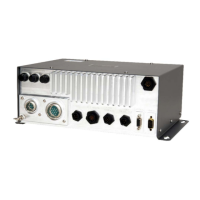
Do you have a question about the JRC JMA-5104 and is the answer not in the manual?
| Brand | JRC |
|---|---|
| Model | JMA-5104 |
| Category | Marine Radar |
| Language | English |
Details precautions for handling high voltage electronic equipment during maintenance.
Provides instructions on what to do if someone experiences an electric shock.
Outlines step-by-step first aid procedures for victims of electric shock.
Explains how to perform artificial respiration using the mouth-to-mouth technique.
Details the procedure for cardiac massage, including combinations with artificial respiration.
Explains the meaning of various danger, warning, and caution symbols used in the manual and on the equipment.
Notes the presence of a warning label on the equipment and advises against its removal or modification.
Lists critical safety warnings and precautions to be observed while operating the radar equipment.
Highlights risks associated with high voltage components within the modulator and scanner units.
Shows images and names of different scanner unit models (NKE-2042, NKE-2062, NKE-2102).
Displays images and names of the processing unit (NDC-1260) and keyboard unit (NCE-7640).
Describes the device's purpose, advanced performance, and user interface features.
Details system components, attachments, spare parts, and general system diagrams.
Provides outline drawings and dimensions for various scanner, processing, and keyboard units.
Explains the keyboard components (keys, knobs, jog dial, track ball) and their primary functions.
Details the functions of individual keys and knobs, including short and long press modes.
Explains the operation and modes of the jog dial and track ball for navigation and control.
Illustrates and labels the various data and indicators shown on the radar PPI screen.
Guides users on how to open, close, and navigate through the radar's menu system hierarchy.
Outlines the fundamental sequence of operations: power-on, tuning, observation, and termination.
Details steps for powering on, tuning, and initial observation adjustments like brightness and language.
Explains transmitting, halting, range changes, sensitivity adjustment, and interference elimination.
Covers clutter suppression, target measurement tools (VRM, EBL), motion displays, and trails.
Explains the use of function keys for settings and managing system information and diagnostics.
Details procedures for system initialization, special modes, and handling incomprehensible symptoms.
Explains how target height and scanner unit height influence radar detection range.
Discusses how radio waves are affected by terrain and weather, and how obstructions can block signals.
Identifies common causes of false echoes such as ghosts, side echoes, indirect echoes, multiple echoes, and radar interference.
Details how to display SART signals for locating survivors in distress situations.
Covers basic cleaning, screw tightening, and connection checks for all units.
Provides specific cleaning instructions for scanner unit radiation sections and display units.
Lists common issues, conceivable causes, and recommended actions for equipment abnormalities and breakdowns.
Outlines procedures for requesting repairs, warranty coverage, and recommended maintenance inspections.
Provides a checklist to assist in identifying and documenting radar malfunctions before requesting service.
Instructs on proper disposal methods for the equipment, batteries, and magnetrons according to regulations.
Lists general technical specifications and detailed specs for scanner, processing, keyboard, and display units.
Details specifications for optional accessories and the lengths of connecting cables.
Covers essential considerations for proper radar unit installation for optimal performance and maintenance.
Provides guidance on selecting scanner unit locations and mounting procedures.
Explains installing indicator units and connecting various cables, including GPS, NMEA, and PC.
Covers changing ship's power settings and lists the types and ratings of fuses used in the equipment.
Outlines procedures for checking installation, operation, and performing necessary adjustments like azimuth and tuning.
Guides on initializing the radar and configuring various receiver and GPS settings.
Details settings for DGPS, WAAS receivers, course/speed data input, and magnetic azimuth correction.